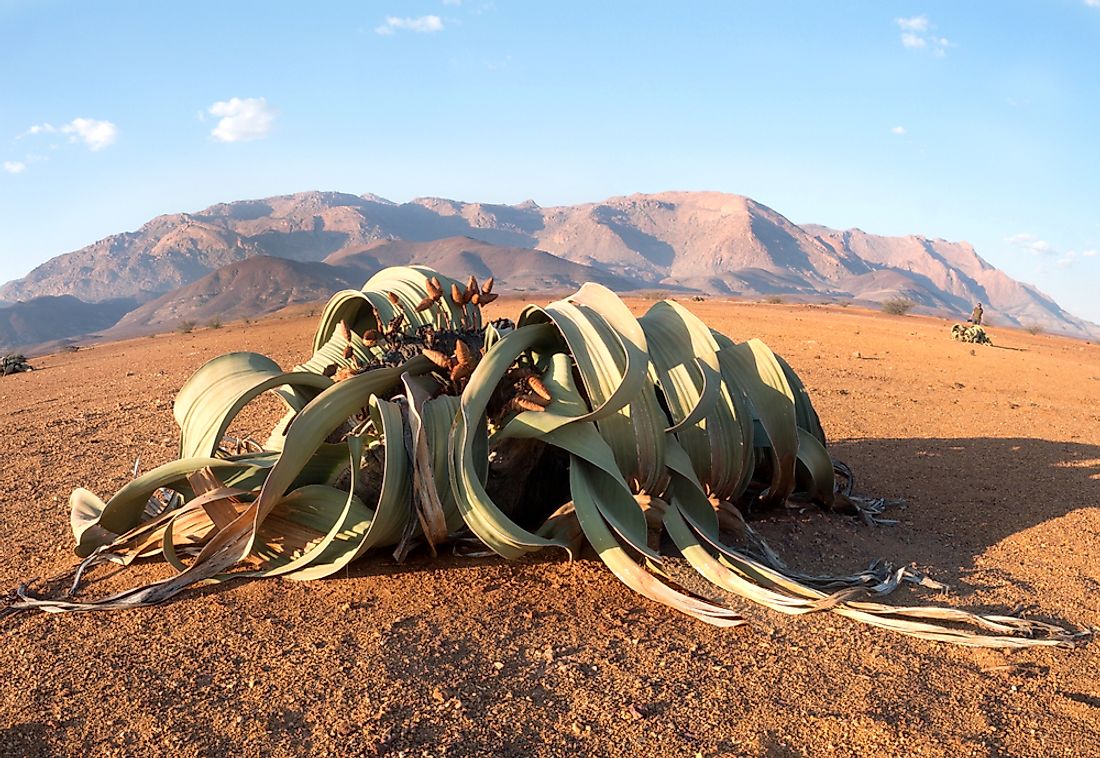The Native Plants Of Angola

Angola is a tropical African nation with a wide variety of ecosystems and microclimates. Arid coastal lowlands give way to green hills and mountains further inland, rising into the high and dry savannah region, eventually leading into northern rain forests. Because of this regional diversity, the country is home to a number of endemic plant species, including grasses, herbs and a couple of highly unique plant specimens.
Living Fossils And Succulent Trees
Welwitschia, also known as tree tumbo is endemic to the arid coastal regions of Namibia and Angola. It is a remarkably long-lived plant, with specimens exceeding 1000 and perhaps even 2000 years in age, which is why it is commonly referred to as a "living fossil". Welwitschia produces only a single pair of leaves, which grow continuously throughout its lifespan. The plant absorbs groundwater through a long taproot, and also takes in moisture from fog and precipitation. Male and female plants are characterized by distinctive reproductive cones: smaller pinkish-red for the male, and a combination of larger pink and greenish-blue for female plants. Because of its low reproduction rate and limited habitat, Welwitschia is vulnerable to threats such as overgrazing, damage by off-road vehicles and disease.
Namib sprokieswoud succulent trees are endemic to Namibia and southwestern Angola. These highly decorative, deciduous trees can be found in deserts and arid savannahs, as well as along rocky escarpments bordering the Namib Desert. Other distinctive characteristics include smooth, silvery bark, droopy bark, and white flower sprays, followed by pods which split to release winged seeds. Succulent stems store water and nutrients to sustain trees during the dry winter months. Edible fruits, leaves and stems provide nourishment to wildlife including elephants, springbok and porcupines.
Herbs
Angolan arammi is a biennial herb which is endemic to tropical Angola, with finely divided leaves and flower sprays that are similar in appearance to Queen Anne’s Lace. Angolan benguellia is a genus of plants in the Lamiaceae family. It is a perennial herb which grows in marshy regions, with narrow opposite leaves on sparse, glabrous stems. Newton's groundsel, or senecio vulgaris, is a flowering annual herb which is part of the Asteraceae daisy family. This flowering annual herb is commonly found throughout Europe, northern Asia and parts of North Africa, where it is considered a weed.
Grasses
Angolan streptolophus is a genus of plants in the grass family. Its only known species is Streptolophus sagittifolius, endemic to Angola. These annuals have a rambling growth pattern, with primary clusters of spikelets ending in flattened bristles. Angolan Piptophyllum Grass is a perennial grass endemic to Angola, with slender leaves growing out of a base which tends to be densely covered with the fibrous remains of old leaf sheaths. Spikelets produce groups of fuzzy florets.
New Discoveries
Because of sparsely-populated areas, remoteness and civil unrest resulting in tens of thousands of uncleared land mines throughout the country, a comprehensive survey of Angola's plant life was not published until 2008. 6,735 plant species have been recorded, 1,000 of them endemic, and more are being discovered to this day.
The Native Plants Of Angola
| Native Plants of Angola | Scientific Name |
|---|---|
| Welwitschia | Welwitschia mirabilis |
| Angolan Aframmi | Aframmi angolense |
| Angolan Benguellia | Benguellia lanceolata |
| Angolan Streptolophus | Streptolophus sagittifolius |
| Newton's Groundsel | Psednotrichia newtonii |
| Namib Sprokieswoud Succulent Trees | Moringa ovalifolia |
| Angolan Piptophyllum Grass | Piptophyllum welwitschii |







